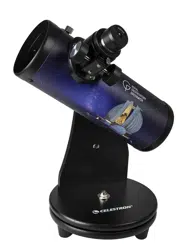Loading ...
Loading ...
Loading ...

ENGLISH | 15
Star Clusters
Star clusters are groups of stars that are packed into a small area. Clusters that have loosely distributed stars are called
open clusters and can contain hundreds of stars. Clusters that are very tightly packed in a small area are called globular
clusters, which can contain hundreds of thousands of stars. For open clusters, you should use low power eyepieces to
better frame the cluster. For globular clusters, try low power first, and then boost up to a higher power to try to resolve as
many of the stars as possible.
Observing the Pleiades
The Pleiades is an open cluster located in the
constellation Taurus the Bull. It is a large open cluster
of very bright blue stars and is easily seen with the
naked eye. It is only about 400 light years from Earth.
This cluster is large and best appreciated with low
power eyepieces. This cluster has been recognized and
recorded by many cultures all over the world. In Japan,
this cluster is known as Subaru and was adopted as the
name and logo of the automobile manufacturer.
Observing the Double Cluster
The Double Cluster in the constellation Perseus is a beautiful telescopic object, or more accurately, objects, since there
are two distinct open clusters in the same field if view. To the unaided eye, this cluster appears as a fuzzy patch in Perseus,
but a small telescope or binoculars resolves this into to open clusters approximately one degree apart. Each cluster
contains a few hundred stars. Be sure to use low power eyepieces with this object to get both clusters together, and then
switch to higher magnification to inspect each cluster in more detail.
Observing the Hercules Globular Cluster
The Hercules Globular Cluster is the most beautiful example of a globular cluster in the northern skies. It is conveniently
located between two bright stars in the constellation Hercules and is just barely visible to the unaided eye on a dark
night as a fuzzy star. It can be seen easily in binoculars, but looks better through a telescope using low to moderate
magnification. This cluster contains hundreds of thousands of densely packed stars.
PRACTICE WHAT YOU HAVE LEARNED: OBSERVING STAR CLUSTERS
Loading ...
Loading ...
Loading ...
